Many of our daily activities depend on mobile phones thanks to the explosive expansion of mobile applications. The apps are accessible for all needs, including booking taxis, hotel rooms, and a restaurant table. Taxi app development is among the ones that have seen a rise in popularity because of the increasing customer demand.
Many people want to create cab booking apps to satisfy the increasing demand. Some cab booking apps have emerged as industry leaders in the world market. For instance, companies such as Uber that allow you to book a cab have expanded into different sectors, such as food delivery and technology. The only way to express the amount of room the apps have for growth would be "massive."
This is why numerous business owners employ app developers to design custom solutions. This blog will guide you to the essential elements of taxi booking app development.
What is a Taxi Booking App?
The car-booking app allows customers to book a taxi using an internet connection and the app's interface. There are two apps: the first is designed for passengers, while the second is intended for passengers. Taxi app development like Ola and Uber share the same interface, which lets passengers enjoy the convenience of carpooling.
An app for booking taxis is an online application that lets you make an instant online reservation. This app is generally created to assist the customer in completing every aspect of the ride, allowing drivers to know the location of the drop, the type of ride, the drop location, and more.
How Does On-Demand Taxi Booking App Work?
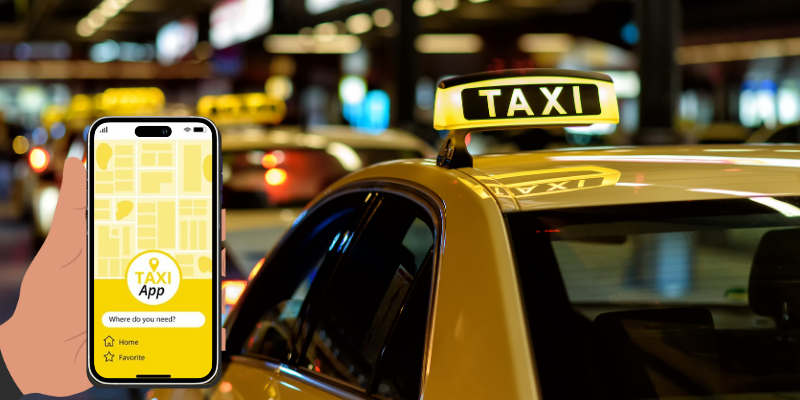
In general, taxi apps are created to connect users with drivers within their area and provide a simple way to book and request a taxi ride. This blog will give a brief illustration of how a taxi booking app development works:
User Registration
Users should download and install the app on their smartphones. After that, they must establish an account by providing the necessary personal information.
Location Services
The application utilizes the smartphone user's GPS to pinpoint the exact location. This is crucial for locating nearby taxis.
Taxi Availability
It communicates to the server to determine if nearby taxis are available to book. The server then inquires about taxi drivers logged into the application and operating within the user's area.
Taxi Driver Acceptance
Taxi drivers can decide whether or not to take the ride depending on their availability and the proximity to the location where the user is. If the driver agrees to an offer, the customer will receive an email that includes the driver's contact information, such as name, picture, and information about the vehicle.
Ride Details
The app provides essential customer information about the ride, including the driver's location on a map, the estimated arrival time, and a trip cost estimate. Users can also review the information and confirm or cancel the reservation.
Real-Time Tracking
When the booking is confirmed, the application starts real-time tracking, which enables users to monitor the driver's location and estimated time as they approach the pickup point.
Ride Completion
When the user has reached their destination, the application calculates the cost based on the distance traveled and duration. Users can also pay directly on the app through the linked payment method.
Rating and Feedback
Following the completion of the ride, passengers and riders can rate each other and leave feedback in the application. Based on the input, it becomes simpler to maintain the quality of the ride and improve the overall experience.
History and Receipts
The application will always account for the user's ride history, pickup and drop-off locations, information about the driver, and any additional costs. Users can look at this information for review, customer support, or expense tracking later.
Also Read : Success Guide to Develop a Taxi Booking App in 2024
Determining the Key Features of Taxi App Development
Your taxi booking app development success is contingent on its features. Select features that meet the app's goals and the driver's and passenger's requirements. Think about the following features:
-
-
Login and User Registration: Drivers and users are offered a simple login and registration process, with the option to join social media accounts and authenticate email addresses.
-
Real-Time Booking: An easy interface lets users instantly book rides, indicating drop-off and pick up places, vehicle types, and ride preferences.
-
The GPS tracking feature: Customers can monitor drivers in real time and get an estimated arrival time (ETA). This enhances transparency and security.
-
Fare Calculation: A dynamic calculation that considers the distance, time traffic conditions, and pricing to give users precise estimations of prices.
-
Secure Payment Integration Various payment options, such as credit/debit cards, mobile wallets, or in-app payment, ensure safe and easy transactions.
-
Profile Management for Drivers: Design, confirm, and manage driver profiles, which include background checks, document submission, and reviews/ratings.
-
The Rating and Feedback system: It is a Two-way system that lets users and drivers give feedback and rate their satisfaction.
-
Administrator Dashboard: A dashboard central to administrators can be utilized to manage drivers and users, bookings, analytics, and payments. This allows for more efficient operation and making choices.
-
Types of Mobile Applications
Mobile apps can be divided into three types depending on the technology used to create their applications and how they're implemented on mobile phones. Understanding the different types of mobile applications can assist developers and businesses in determining the best strategy to meet their requirements and budgets. This is a list of the three significant kinds of mobile apps:
Native
Native applications are explicitly developed for specific platforms and operating systems, like iOS, Android, or Windows. They are directly installed on the device and can fully utilize all its functions, such as the GPS camera, accelerometers, compasses, contact list, and more. They are also directly compatible with your operating system, like iOS for Apple devices or Android for Android devices, making them quick and effective.
Development of Native Applications
-
-
iOS Developers: Use Xcode as their integrated development environment and can code using Objective-C and Swift. This iOS SDK provides essential tools for interface elements, interface components, and software applications for application development, installation, running, and testing.
-
Android: Android apps are typically developed using Android Studio, which uses Kotlin or Java. It is part of the Android SDK, which offers libraries, emulators, debuggers with sample code, and tutorials to help you learn.
-
Windows: Apps are designed with Microsoft's Visual Studio. Developers typically program using C# or VB.NET with Microsoft's .NET framework.
-
Web-Based Applications
Web-based applications are accessible via an internet browser on a mobile device. Instead of being traditional app websites, they are created to mimic native applications. Web-based applications are typically built using HTML5, CSS, and JavaScript.
Development Technologies for Web-Based Applications
-
-
Frontend (Client Side): HTML, CSS, and JavaScript constitute the fundamental technologies, which are often extended by libraries and frameworks like React, Angular, or Vue.js.
-
The backend (server side): Technologies could be PHP, Python (utilizing frameworks such as Django and Flask), Node.js, Ruby on Rails, Java, and .NET.
-
Database Management: The most common databases are MySQL, PostgreSQL, MongoDB, and Oracle, which store, retrieve, and manage data.
-
Web servers: Apache, Nginx, and Microsoft's IIS are extensively used to host websites.
-
Hybrid Applications
Hybrid applications combine the benefits of native and web-based apps. They are built using web-based technologies like HTML, CSS, and JavaScript and enclosed inside a native device, allowing them to access specific functions. Hybrid apps are designed to offer an equilibrium, combining the strengths of native apps with the convenience of web-based applications.
Development Frameworks for Hybrid Applications
-
-
Apache Cordova/Adobe MobileGap: The framework allows developers to create apps using HTML, JavaScript, and CSS wrapped inside an application shell native to the platform.
-
Ionic: It is built on the foundation of AngularJS and Apache Cordova. It offers tools and services for creating hybrid apps that combine web technologies.
-
React Native: A framework developed through Facebook, allows developers to create apps using JavaScript and React. Unlike other hybrid software, it lets developers develop real-time natively rendering mobile applications.
-
Flutter: Flutter is a product developed by Google Flutter; it can be used to create high-quality natively compiled mobile, web, and desktop apps from one codebase that uses Flutter, which is the Dart language. While it's not strictly a hybrid application in the conventional sense, Flutter bridges the gap between hybrid and native by utilizing a unique method of UI rendering.
-
How do you Build a Taxi App in Steps?
You probably need an internal development team if you manage a taxi business or transportation company. If you decide to build an app that allows taxis to take customers, you have two choices: either hire an internal team or outsource the taxi booking app development company that develops apps for external experts.
The first one takes a lot of time, energy, and cash. It's also connected to a myriad of issues with recruitment. Ultimately, it is more sensible for you to work with a trusted development partner.
Here's a step-by-step guide to taxi booking app development.
Analyze the Market and Competition
An extensive market and competition analysis is vital before you embark on the exciting journey of developing taxi apps. It's similar to having a trusted compass that guides you through the present terrain, revealing potential dangers and providing profitable routes to success. Let's explore the most essential elements of this crucial process.
-
-
Market research involves analyzing market size, growth, demographics, laws, and legal landscape. Analysis of competition involves:
-
Identifying important players.
-
Establishing a unique selling proposition (USP).
-
Figuring out market trends and pricing.
-
By following this procedure, companies can lower risk and make more informed choices, find market opportunities, identify competitive advantages, implement the development process based on data, and improve marketing and advertising strategies.
If you invest in a thorough market and competitor analysis, you can equip your taxi app development process with a helpful map. This data-based analysis method enhances your understanding of the terrain, allowing you to make better choices and improving your chances of creating an efficient and long-lasting taxi app that users love and makes a mark in the market.
Decide on the Features and App Requirements
Before you start designing your application, you should determine your market and outline the features you want to add. Start by understanding your audience's preferences and needs. This will help you design an application that fulfills their requirements and ensures a positive user experience.
Once you have identified your company's intended market, you must determine the features you want to add to your application.
Define the Monetisation Strategy
The right monetization strategy is essential to the performance of the taxi booking app development. It will determine how you earn income to fund your service and keep passengers and drivers happy.
Strategies for monetization:
-
-
Commission fees. It is the most well-known method, in which you charge an amount of the cost as a commission for every completed ride. The benefit is that your profit directly corresponds to the use of your platform.
-
It fixed booking charges. Pay a flat rate per reservation, regardless of the distance to be traveled or cost. This could appeal to those on a budget or short-term customers.
-
Surge pricing. The ability to increase prices dynamically during peak-demand periods or in particular high-demand regions. This will encourage drivers to be active during busy periods and create additional revenues for your service.
-
In-app advertising. Adverts that are targeted in the app and generate income from clicks or impressions. This is an excellent alternative if you have large numbers of users.
-
Value-added services. Provide additional services, like airport transfers, car rentals, or food delivery through your app, and charge extra fees. This will expand your services and help you attract new customers.
-
Data monetization. Analyze anonymous user data and travel patterns to give insights for other companies (e.g., local eateries and retailers) for a fee. It can be a subtle method to earn income without impacting users' experience.
-
There needs to be a universal approach to monetization that works for everyone. The best strategy will be based on your particular conditions and your intended audience. Consider testing various models and studying user feedback to determine the most efficient and sustainable method for your website.
Hire a team of developers with Backend and Mobile App Experience.
Finding the best development team with backend and mobile app experience for the taxi booking app development is vital to ensuring the development process is smooth and successful.
Set the stage for your needs and budget.
Define the functions, features, and technology stack you require to build both the backend and mobile components of your app. Determine the specific roles you need, including backend developers, mobile app developers, UX/UI designers, quality assurance testers, and even project managers. Set your development budget, which includes salary, software licenses, and possible outsourcing costs.
Explore Different Options
-
-
Freelance developers: You might consider hiring freelancers on their own when working on small projects or skills gaps you need to fill. Platforms such as Upwork, Toptal, and Fiverr can connect you with skilled app developers.
-
-
-
Development agencies: Find agencies that specialize in developing mobile apps and have experience in taxi app development and similar applications.
-
In-house team: Setting up your own team provides more control, but it also requires a long commitment and an initial investment.
-
Assess teams that could be a good fit.
Check out the team's previous projects and focus on those similar to the taxi booking application. Request thorough case studies and client reviews. Ensure that the team includes developers skilled in the technology you require for your application, including mobile and backend. Examine their communication skills and their ability to comprehend your goals and vision clearly.
Effective communication and cooperation are vital for the success of a project. Compare the prices and rate options provided by various teams. Based on your particular needs and budget, consider project-based contracts, hourly rates, or retainer contracts.
Tools and Resources
Online platforms such as Clutch, GoodFirms, and Toptal can help you compare and connect with taxi booking app development company. Platforms for freelancers like Upwork and Fiverr give you access to many developers. Forums and online communities like Stack Overflow and GitHub allow you to interact with developers and gain insight into the development process.
Create UX/UI
To keep users coming back, you need an appealing and user-friendly layout. Make sure you have a user-friendly interface (UI) and a pleasant User Experience (UX). The color scheme, fonts, and iconography must be carefully thought through to ensure that the app is consistent with your brand's identity and offers a pleasant user experience.
Develop the Taxi App
The development stage is the most challenging and time-consuming phase of the process. In this stage, the team you have chosen to develop with will consider your concepts and transform them into a top-quality and functional taxi application.
Developing the server-side logic for the taxi booking application will require implementing robust features to manage user requests efficiently, handle data, and ensure real-time communication with passengers and drivers. During this phase, you'll be required to:
-
-
Authorization and authentication for users;
-
Create ride management and matchmaking algorithms;
-
Implement secure payment processing;
-
Control data storage and retrieval;
-
Continuously monitor and maintain.
-
Create a solid database system.
-
The implementation of a reliable database system is vital to the performance of your booking taxi application. This system ensures uninterrupted data storage, retrieval, and management.
When they are completing this step, developers must:
-
-
Select between SQL or NoSQL databases;
-
Set data integrity restrictions;
-
Improve performance to allow real-time data handling.
-
Secure access to and storage of data;
-
Monitor and monitor the performance of the database.
-
Develop the client part of the app to serve passengers and drivers.
-
The client side of a taxi app requires the creation of separate apps for drivers and passengers, each with distinct capabilities and features.
-
Passenger apps typically include payments, location tracking, feedback, and rating systems.
Driver apps provide the primary overview of the dashboard and are tools for optimizing routes and communications.
Integrate with APIs of other companies to provide services such as payment processing.
Integrating APIs from other sources in your taxi booking application is vital for providing crucial services such as payment processing, location tracking, and routing optimization. This article will show you how to do it correctly.
-
-
Determine the APIs required, such as payment processing, routing optimization, location tracking, and driver authentication.
-
Choose secure APIs based on their security, reliability, and upgradability.
-
Use proper authentication methods, such as API keys, authorization headers, and a rate limit.
-
Make sure that error handling and logging are properly handled, such as an error callback feature, detailed logging, and the ability to recover from errors.
-
Use proper data formatting and ensure it is in a compatible format.
-
Test the Taxi App for Functionality, Usability, and Security
A thorough test of a taxi app is vital to ensure a smooth user experience, safe processing of data, as well as reliable performance.
Functionality testing includes booking rides, tracking locations, payment processing, notifications via push, and handling errors.
Security testing covers access control, data encryption, authenticating inputs, and scanning for vulnerabilities.
Usability testing tests for the User Interface (UI) and the User Experience (UX), including performance testing devices, compatibility testing, and testing localization.
Release the App and Collect Feedback
Launching a taxi booking app through app stores and obtaining feedback is essential to ensure an effective launch and ongoing development.
You will need to review applications to the app store, formulate the launch plan, and collect feedback with the aid of tools such as an in-app feedback system and social media engagement. Reviews requests and interviews.
Other crucial things to consider are data analysis and the ability to implement insights.
Promote the Taxi App to get Clients.
Let's examine some marketing tips to draw users to your app for booking taxis.
First, you must make use of the popular local social media. First, you must decide which social media platform to use. You must be aware of what platforms your users use most to reach them. After deciding where you want to advertise, make sure you promote your app with vigor on every relevant platform to your audience.
Pay attention to advertising channels like Google Adwords and advertising on social networks like Facebook or Instagram.
Another great idea is to gain local media coverage that will create interest among potential users within your region. You could also promote your app in local newspapers, on radio, and on TV.
Highlight your application's unique features to make it stand out and distinguish it from your competitors. You can also submit your application to various app review websites before it is released.
You can employ a variety of other methods to advertise your taxi app. These include partnerships with businesses in the area, brand initiatives, promotional and discount offers, and more.
Also Read : Ideas For Taxi Booking App Development
How Much Does it Cost to Build a Taxi Booking App?
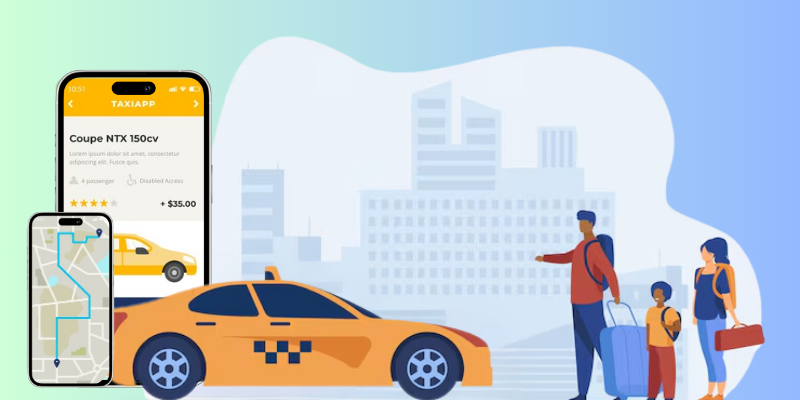
A variety of factors affect the cost of creating an app with many features for booking taxis. Business, technological, and geographic factors are taken into account when assessing the application's breakdown of costs.
Here are a few of the significant cost drivers driving the taxi booking app development:
Features
The features in your ride-hailing app will determine if it can be classified as simple or advanced. The app becomes more effective when you add more advanced features that we include. The development costs eventually increase because current mobile app development also depends on adding APIs that provide new capabilities.
Technology Stack
Utilizing technology within the Mobile app development stack is important in determining the application's expense. It is suggested that the most efficient, modern, and cost-effective technologies be chosen for both the front and back ends of the app.
Efforts in Development and Design
A fully functioning ride-hailing application comes from the effort covered, from the design phase to development. The complexity of your app and project will determine the required steps.Taxi booking app development is more expensive as a result.
Location of Service Providers
The geographical area of the company that develops apps that customers benefit from has a significant impact. Firms headquartered in the USA, Australia, the UK, and other Western countries could charge higher for their services than companies based in Asian countries such as Japan, India, Bangladesh, India, the Philippines, Indonesia, and others.
Updates
The cost of developing the app for ride-hailing on-demand will likely increase when requirements are modified and the application experience changes after development. When constructing the prototype, a comprehensive list of potential needs is suggested. Meetings between service providers and customers should be utilized to make these adjustments after the prototype is produced.
Also Read : Startup Ideas for On-Demand Taxi App in 2024
Tips to Consider: Taxi Booking App Development
Keep the Layout Simple
If you are developing an online taxi app such as Uber, ensure that the business model is flexible and easy to use. If you're a novice to this industry and wish to begin using taxi app development in 2024, consider the ease of access for the user.
Millions of people are using the Uber app due to its simplicity, ease of access, and user-friendly features. In the beginning phase, you can also reduce your expenses.
Cross-Platform Application
Creating applications for a particular platform can be a waste of money. Developing cross-platform applications is a smart choice.
As a business owner, you must aim to reach an extensive audience across different platforms. The cross-platform app saves you time and money.
Troubleshooting
It is essential to concentrate on improving and fixing the errors and bugs within your app before it goes live. Employ seasoned Mobile app developers to provide valuable suggestions and ideas to reduce the overall cost.
Consider Features & Functions
This year and the coming year are expected to be great for all taxi app development company. If you're thinking of launching your own online taxi booking application, implement the features your customers would like. Avoid irrelevant features that can make an application bloated.
Conclusion
The transportation sector has tremendous potential to develop, grow, and even disrupt the industry by creating the first taxi-booking app by 2024. This guide will help create an app for booking taxis that offer unbeatable convenience, reliability, and customer satisfaction. Begin your taxi booking app development process with creativity, flexibility, and a focus on customers, and watch your taxi booking app grow amid a crowded market in 2024.







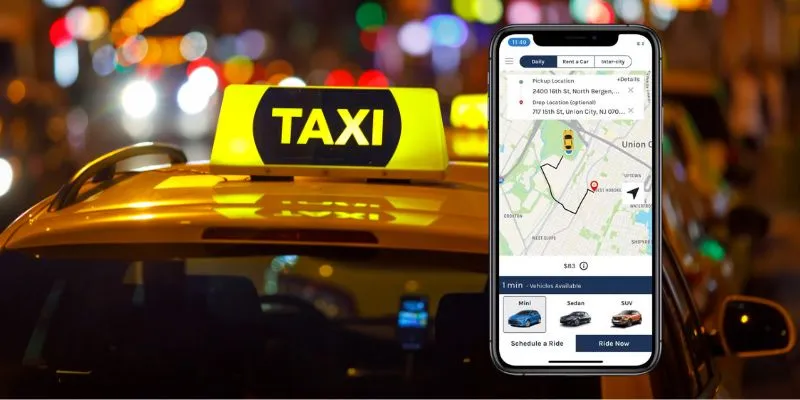
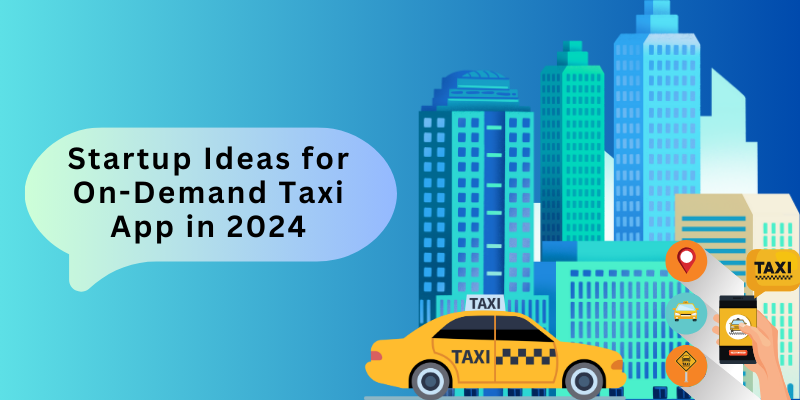
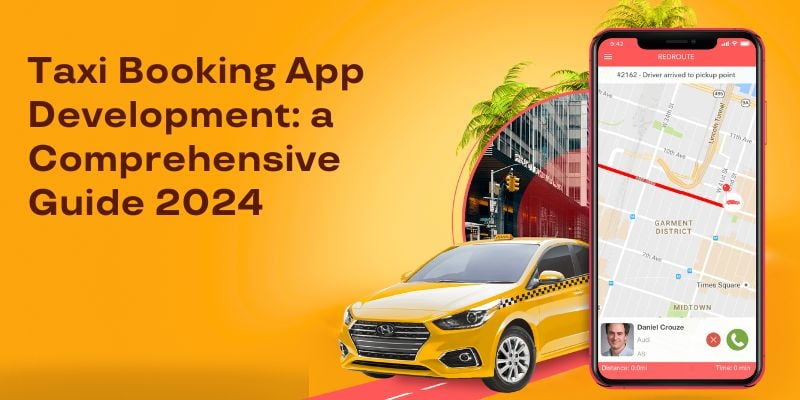



Share this blog